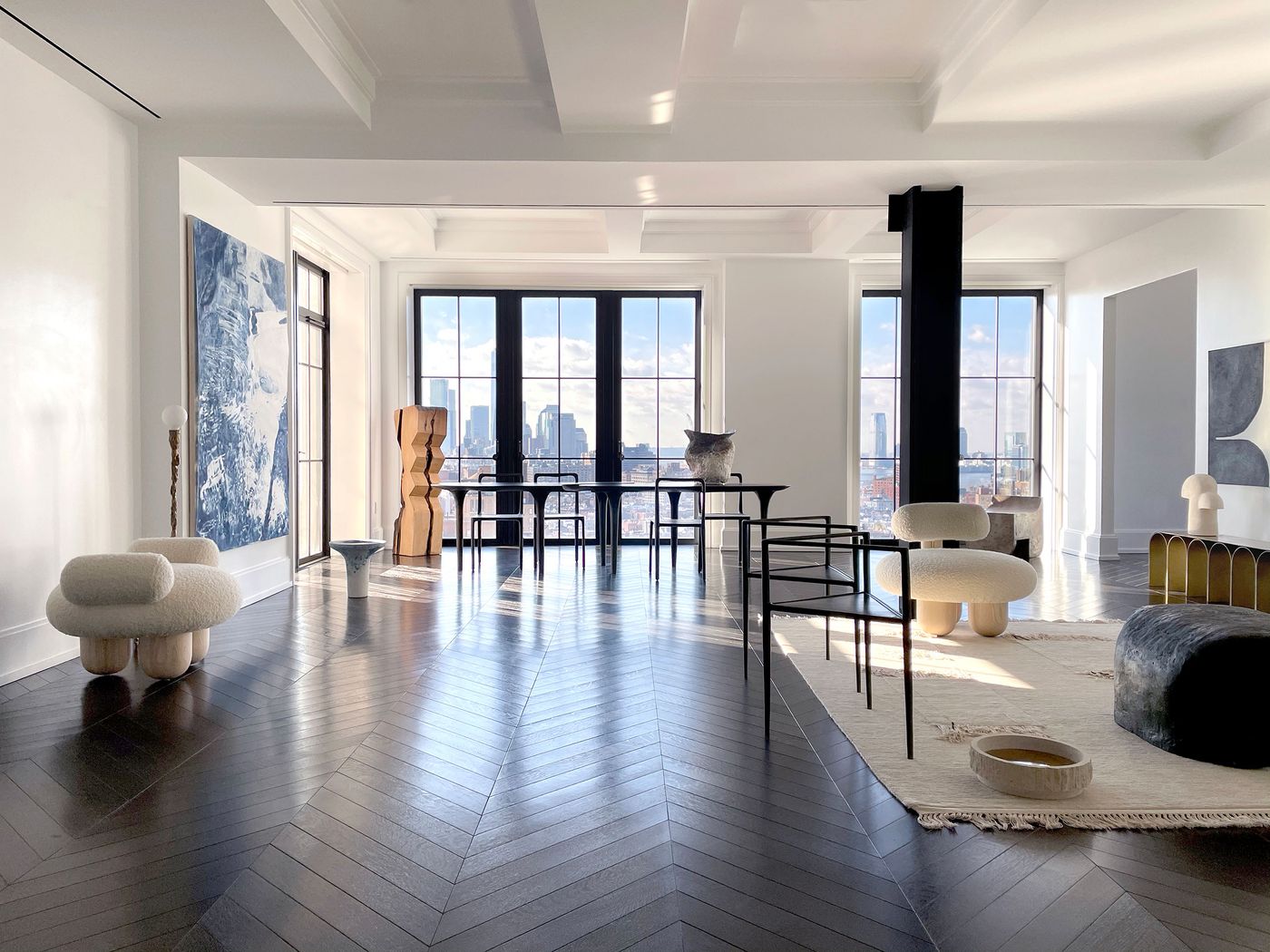
New York's Skyline Uplifts Galerie Philia's Art & Design Exhibition at Walker Tower
Words by Eric David
Location
New York, United States
New York's Skyline Uplifts Galerie Philia's Art & Design Exhibition at Walker Tower
Words by Eric David
New York, United States
New York, United States
Location
Taking over a two-floor, loft-style apartment in New York City’s Walker Tower, an iconic Art Deco building in Chelsea, Galerie Philia’s latest exhibition of collectible design offers visitors the chance to admire works of exceptional style and craftsmanship alongside breathtaking views over Downtown New York. Co-curated in collaboration with Italian architect and designer Pietro Franceschini, the exhibition is set up like a liveable apartment, showcasing over 70 works by 40 international designers represented by Galerie Philia, a Geneva-based contemporary design and modern art gallery with outposts in New York and Singapore. The exhibition, which runs until May 15, is part of a series of temporary exhibitions across the world aiming to introduce the gallery’s emerging as well as established designers to new audiences.
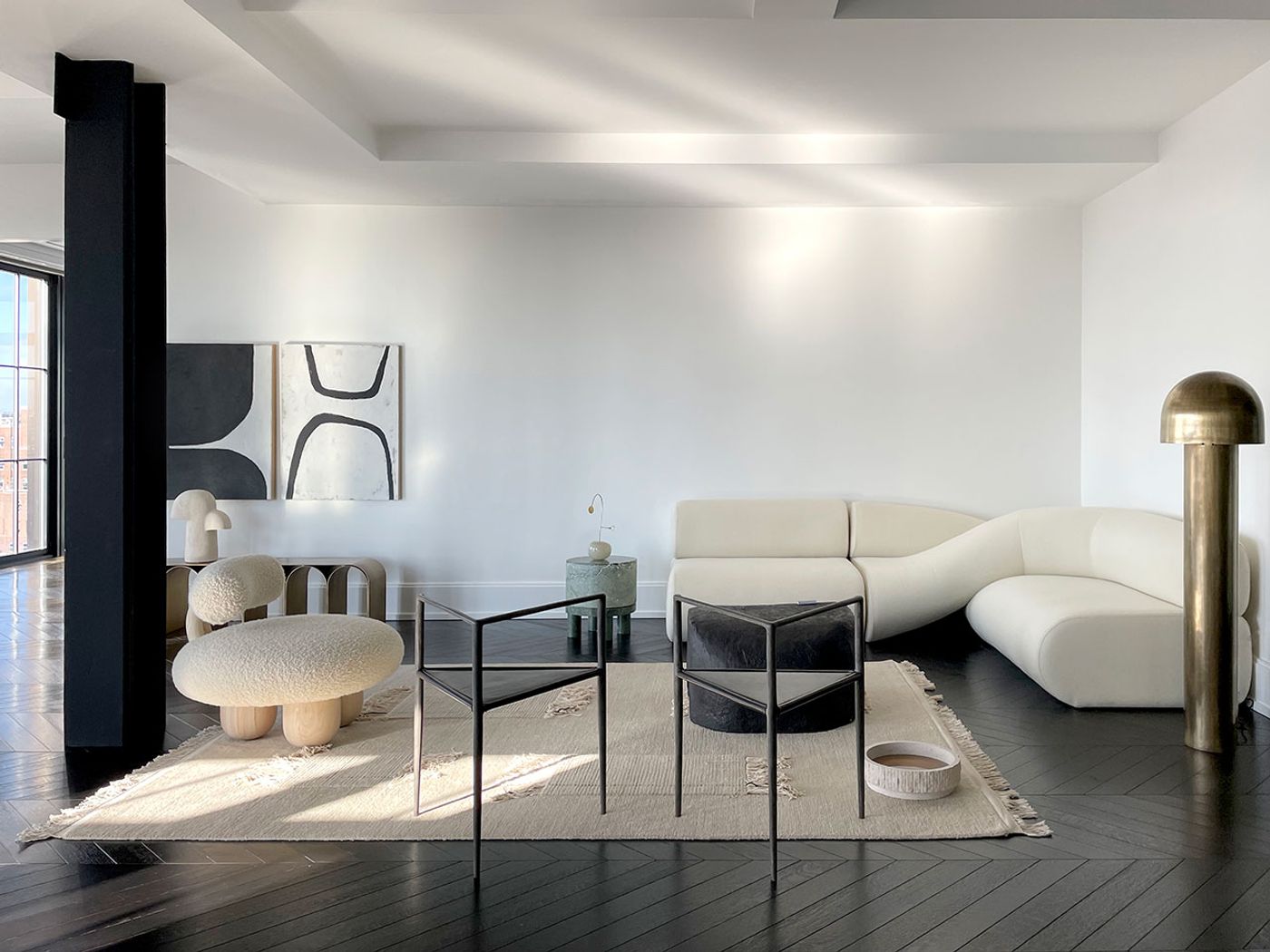
Galerie Philia at Walker Tower, Chelsea, New York. Courtesy of Galerie Philia.
Featured:
Pietro Franceschini, Bling Bling Chair, 2020. Ash Wood, Lamb. 79 x 79 x 75 cm.
Rick Owens, Alchemy chair, 2012. Bronze, Leather. 62 x 50 x 71 cm.
Nina Edwards, Landscape sofa, 2020. Textile, wood.
Paul Matter, Monolith Brass Sculpted Floor Lamp. Brass. 38 x 38 x 147.3 cm
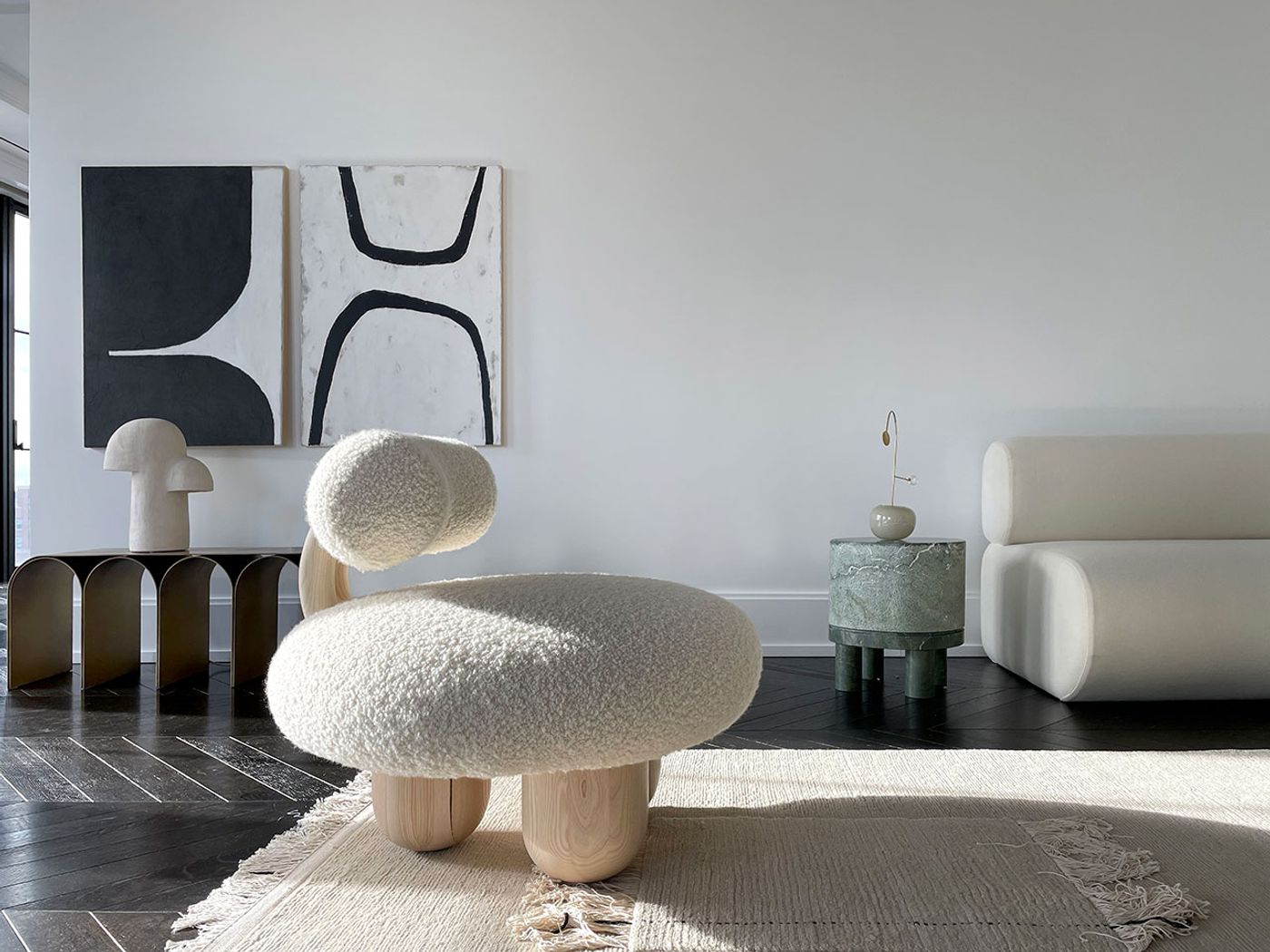
Galerie Philia at Walker Tower, Chelsea, New York. Courtesy of Galerie Philia.
Featured:
Fino Prydz, Untitled 13 & Untitled 11, 2020. Plaster, gesso, indian ink, cold wax on birch panel. 76.2cm x 101.6cm.
Elisa Uberti, Édifice table lamp, 2020. White stoneware. 44 x 34 x 18 cm.
Pietro Franceschini, Brass Gold Arch Bench, 2020. Brass. 155 x 33 x 43 cm.
Pietro Franceschini, Bling Bling Chair, 2020. Ash Wood, Lamb. 79 x 79 x 75 cm.
Rooms, Life On Earth, Stool / Side Table, 2018. Diabase stone. 43.6 x 43.4 x 45 cm.

Galerie Philia at Walker Tower, Chelsea, New York. Courtesy of Galerie Philia.
Featured:
Fino Prydz, Untitled 13 & Untitled 11, 2020. Plaster, gesso, indian ink, cold wax on birch panel. 76.2cm x 101.6cm.
Elisa Uberti, Édifice table lamp, 2020. White stoneware. 44 x 34 x 18 cm.
Pietro Franceschini, Brass Gold Arch Bench, 2020. Brass. 155 x 33 x 43 cm.
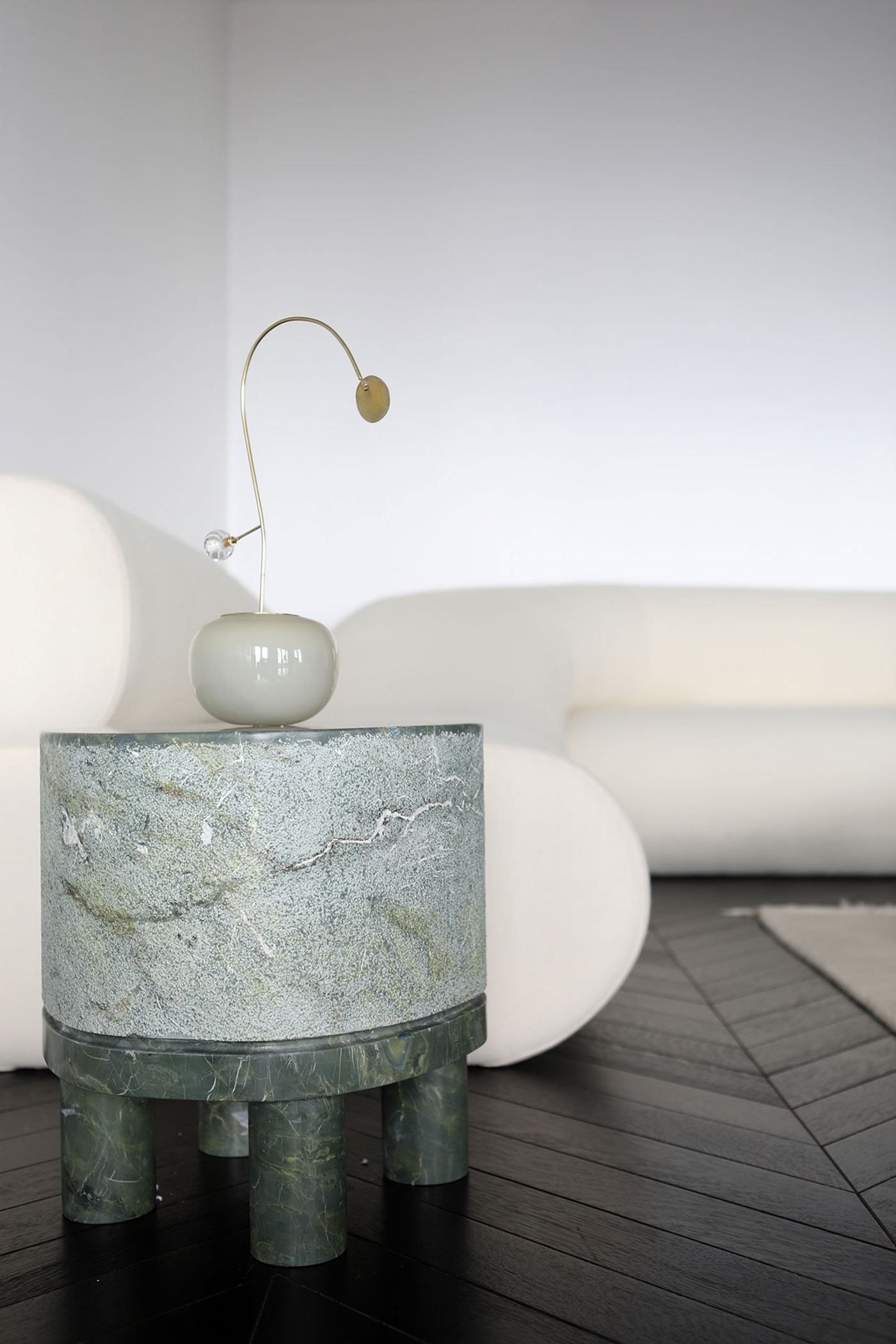
Galerie Philia at Walker Tower, Chelsea, New York. Courtesy of Galerie Philia.
Featured:
Rooms, Life On Earth, Stool / Side Table, 2018. Diabase stone. 43.6 x 43.4 x 45 cm.
Nina Edwards, Landscape sofa, 2020. Textile, wood.
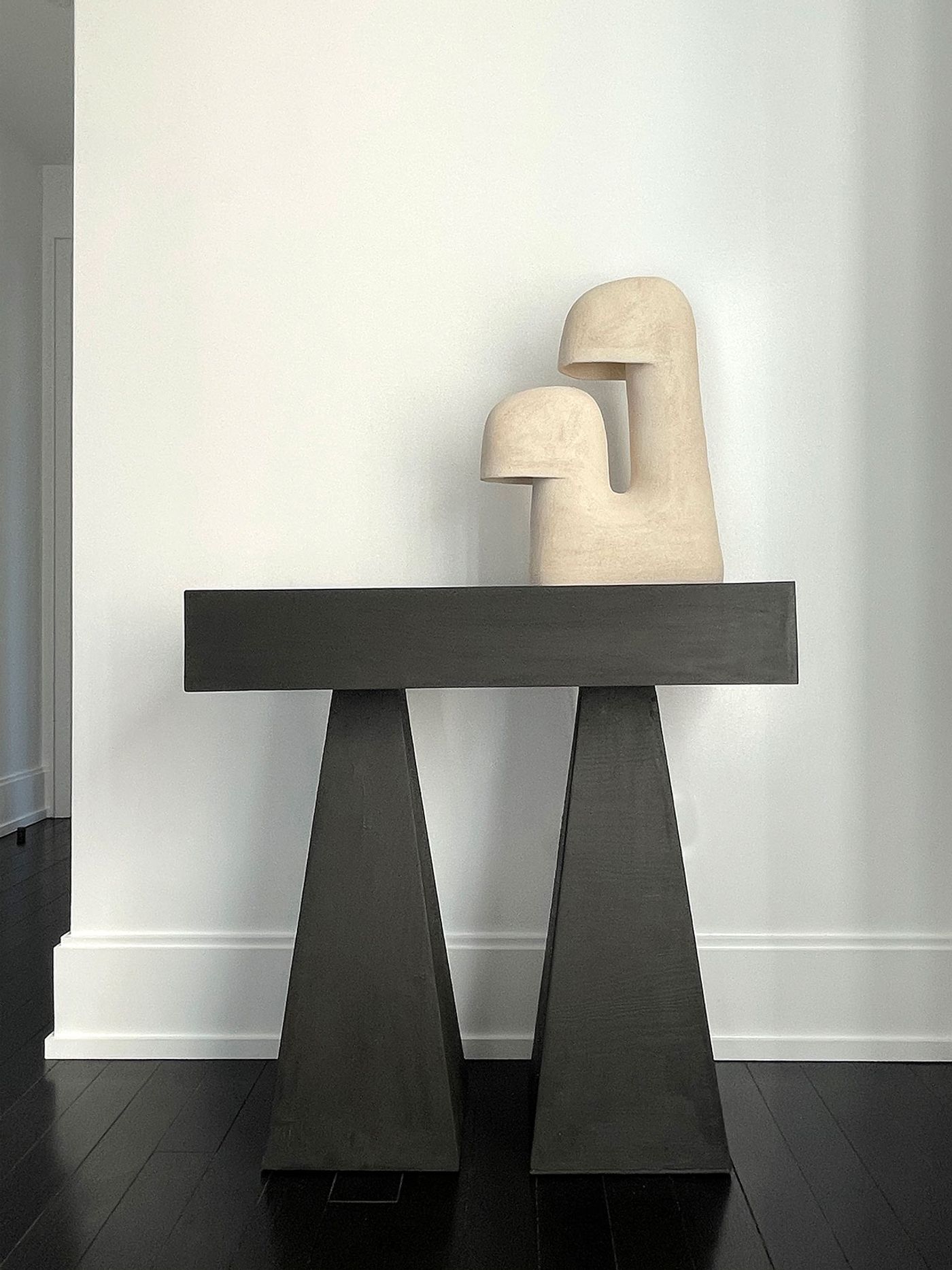
Galerie Philia at Walker Tower, Chelsea, New York. Courtesy of Galerie Philia.
Featured:
Elisa Uberti, Édifice table lamp, 2020. White stoneware. 53 x 39 x 15 cm.
Lucas Morten, Torn, High Console Table, 2020. Wood. 90.5 x 40 x 89 cm.
Built in 1929 by architect Ralph Walker, a key figure of the Art Deco architectural movement in America, the 23-story Walker Tower epitomizes New York’s Art Deco heritage with its Gotham-like set-backs, rhythmic brick patterning and external ornamentation. Its most impressive asset nonetheless can be found inside, especially from the upper floors, as is the case with Galerie Philia’s temporary venue which features panoramic views of the New York skyline, courtesy of tall ceilings and floor-to-ceiling windows throughout the apartment. White walls and dark hardwood floors round up the austere interiors allowing the furniture and decorative objects that are on display to take centre stage.
Exemplifying the gallery’s diverse roster of international artists and designers, the works on view range in discipline, materials and style but share a minimal aesthetic, albeit not reductive as Franceschini points out showcasing a neutral colour palette of mostly black, white and brass, along with a focus on craftsmanship. Sculptural in conception and primitive in sensibility, many pieces project a masculine vibe, but at the same time hint at a feminine side through sinuous, slender or evocative forms, while others hover between the natural and manmade, and chaos and order. Take for example, American designer Evan Fay’s “Lawless” hand-sculpted fauteuil which combines a chaotic tangle of foam tentacles with the geometric orderliness of a scaffold-like structure, or acclaimed fashion designer Rick Owen’s “Stag” side table made out of moose antlers and two plywood planks.
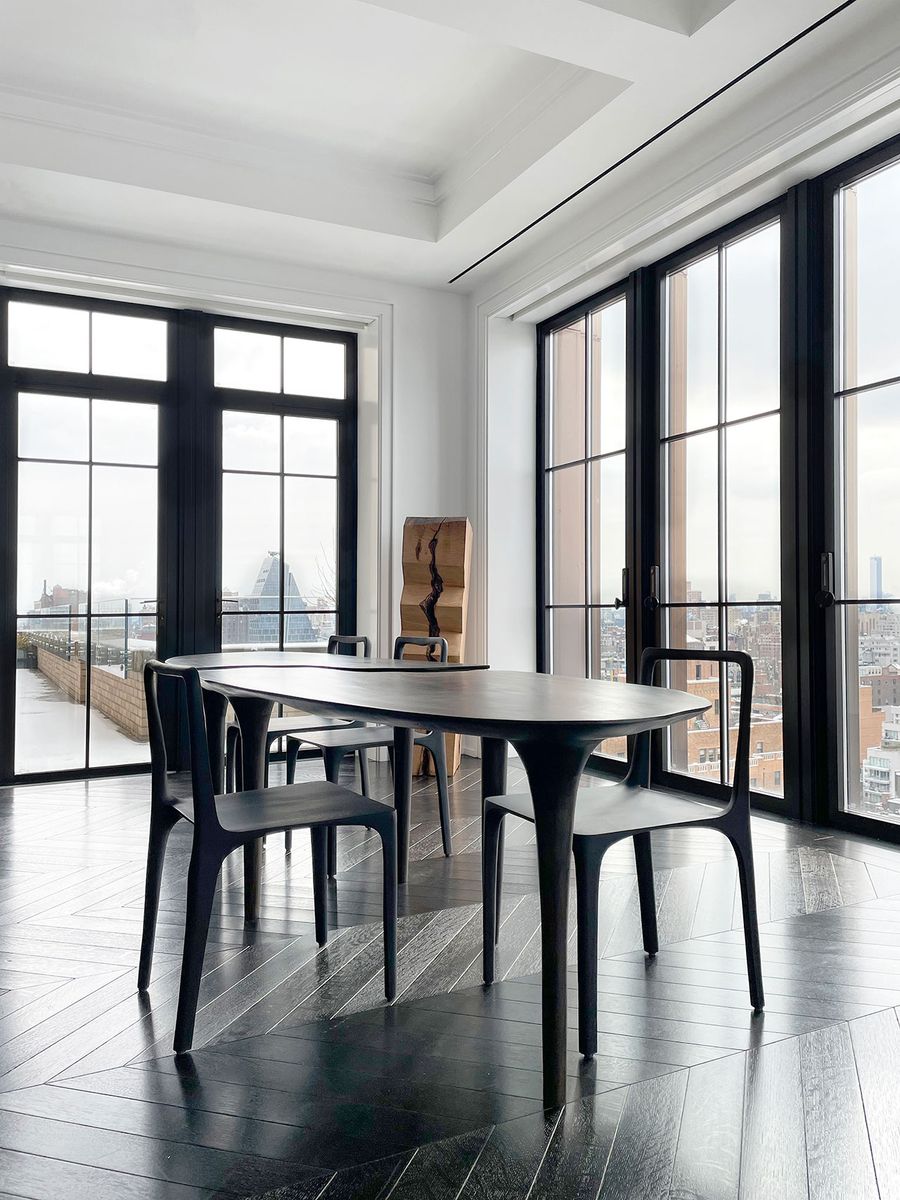
Galerie Philia at Walker Tower, Chelsea, New York. Courtesy of Galerie Philia.
Featured:
Vince Skelly, Corsica Tower, 2020. Oak. 30 x 30 x 127 cm.
Cedric Breisacher, Dot chair, 2020. Hand-sculpted solid oak. H 46/80 cm x P 44 cm x L42 cm.
Cedric Breisacher, Dining table, 2020. Hand-sculpted plane tree.
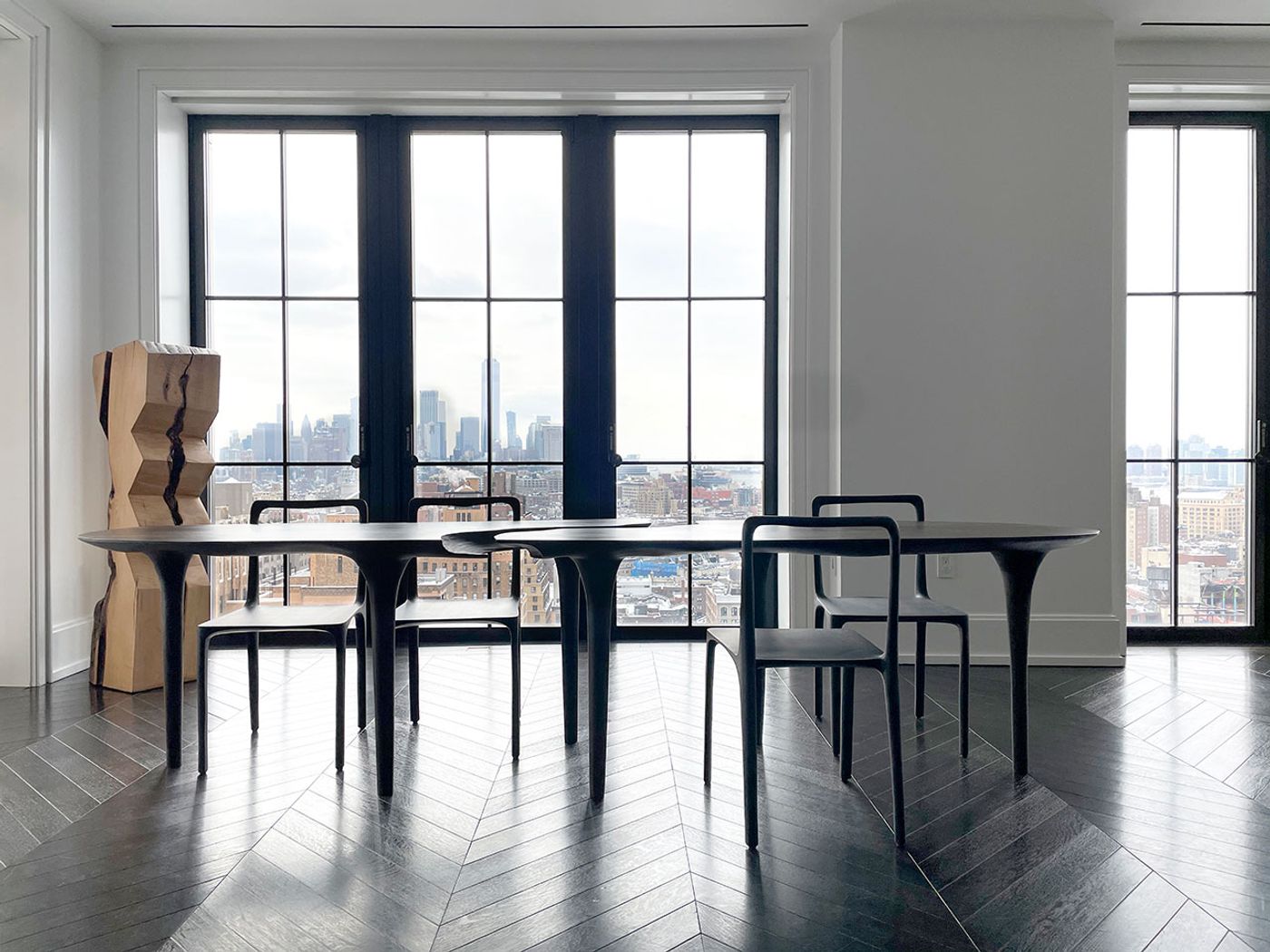
Galerie Philia at Walker Tower, Chelsea, New York. Courtesy of Galerie Philia.
Featured:
Vince Skelly, Corsica Tower, 2020. Oak. 30 x 30 x 127 cm.
Cedric Breisacher, Dot chair, 2020. Hand-sculpted solid oak. H 46/80 cm x P 44 cm x L42 cm.
Cedric Breisacher, Dining table, 2020. Hand-sculpted plane tree.
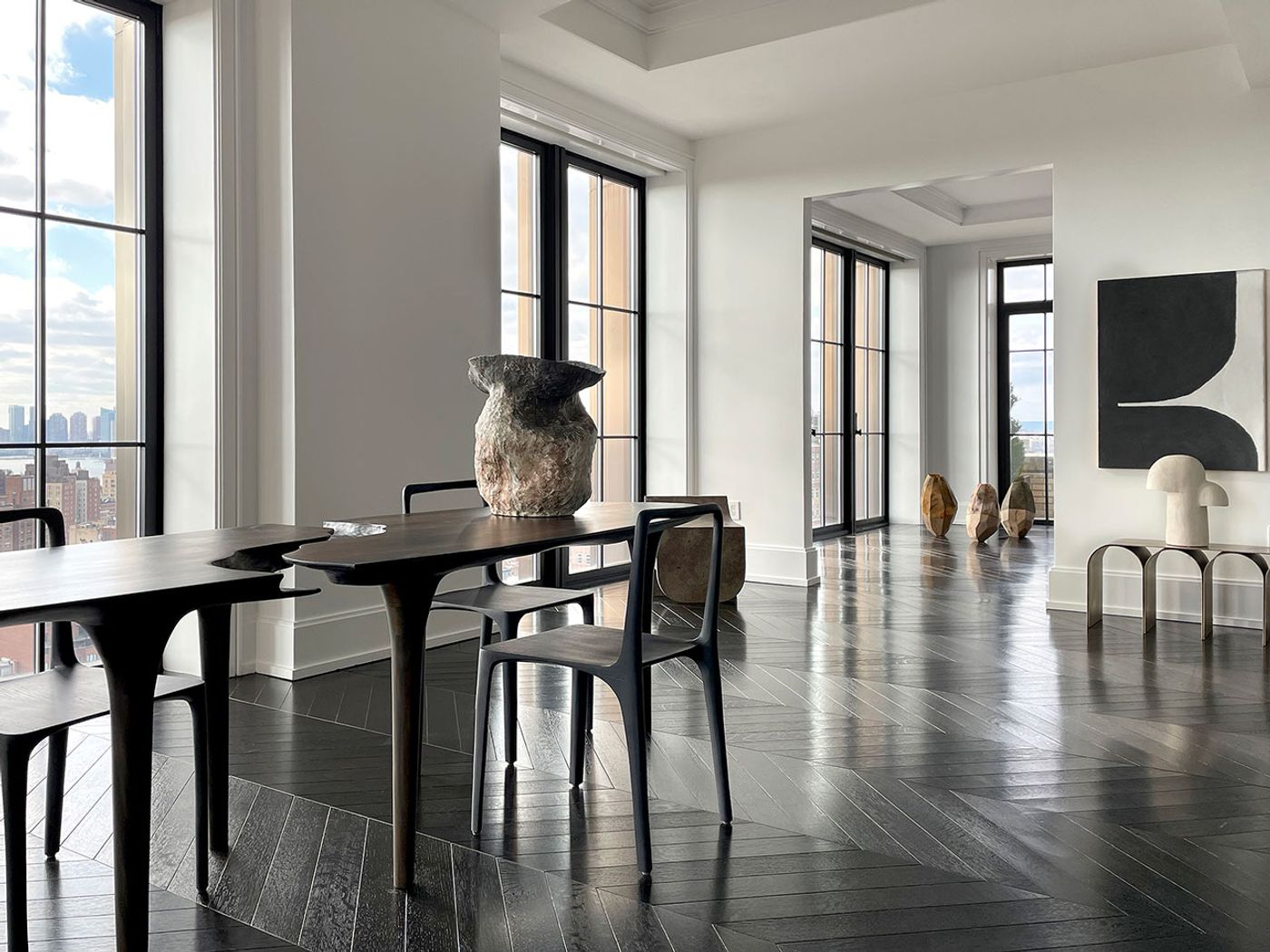
Galerie Philia at Walker Tower, Chelsea, New York. Courtesy of Galerie Philia.
Featured:
Vince Skelly, Corsica Tower, 2020. Oak. 30 x 30 x 127 cm.
Cedric Breisacher, Dot chair, 2020. Hand-sculpted solid oak. H 46/80 cm x P 44 cm x L42 cm.
Cedric Breisacher, Dining table, 2020. Hand-sculpted plane tree.
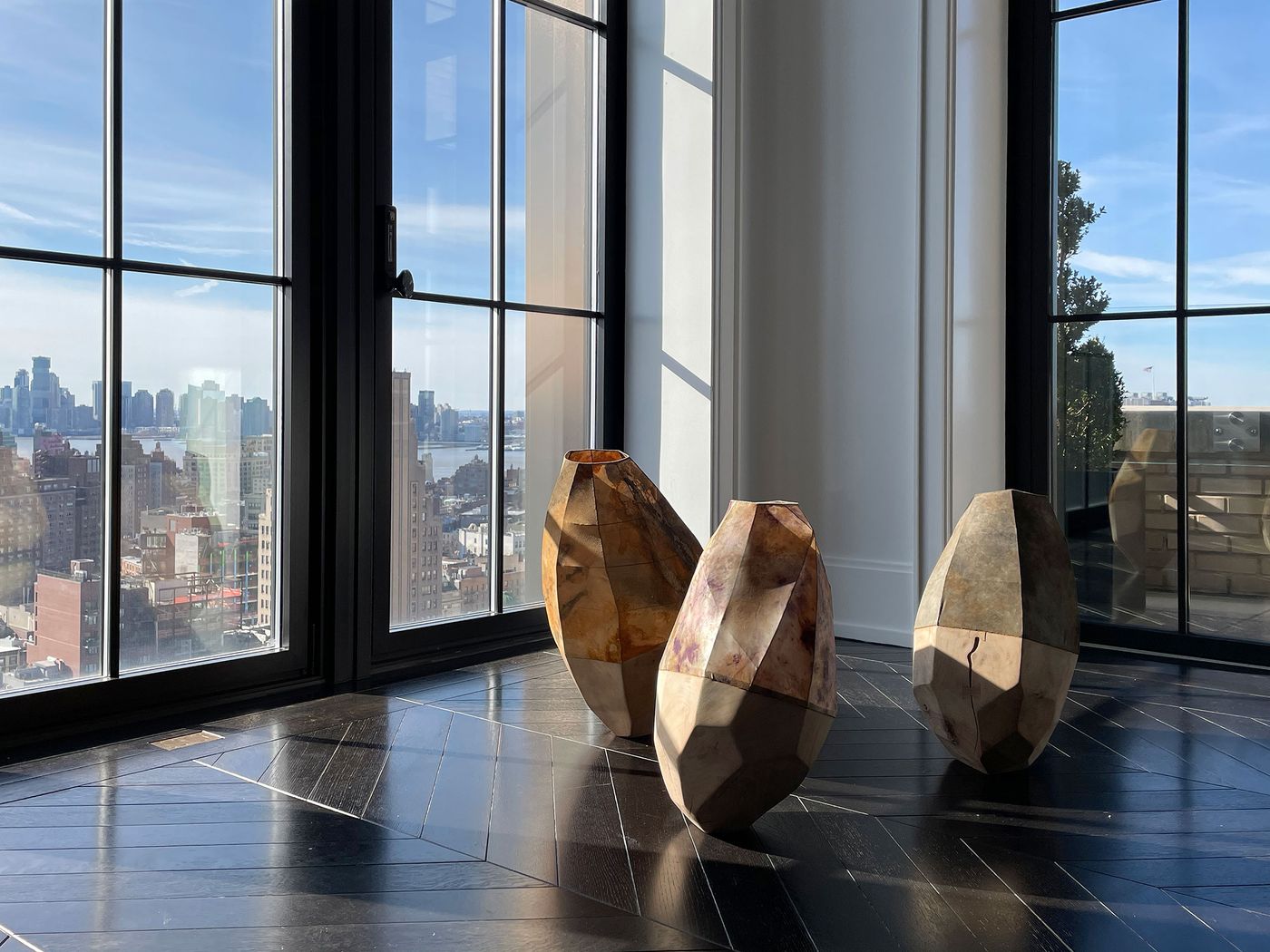
Galerie Philia at Walker Tower, Chelsea, New York. Courtesy of Galerie Philia.
Featured:
Sylvia Eustache Rools & Jérôme Pereira, Corps Céleste & Telluric Sculptures, 2020. Natural Dyed Silk, Oxidation, Pigments, Plane Tree.

Galerie Philia at Walker Tower, Chelsea, New York. Courtesy of Galerie Philia.
Featured:
Cédric Breisacher, White Butterfly Stools, 2018. Ash. 45 x 41 x 42 cm.
Frederik Bogaerts & Jochen Sablon, Gestalt Bench, 2019. Marble, Pigmented Concrete. 49 x 63 x 31 cm.
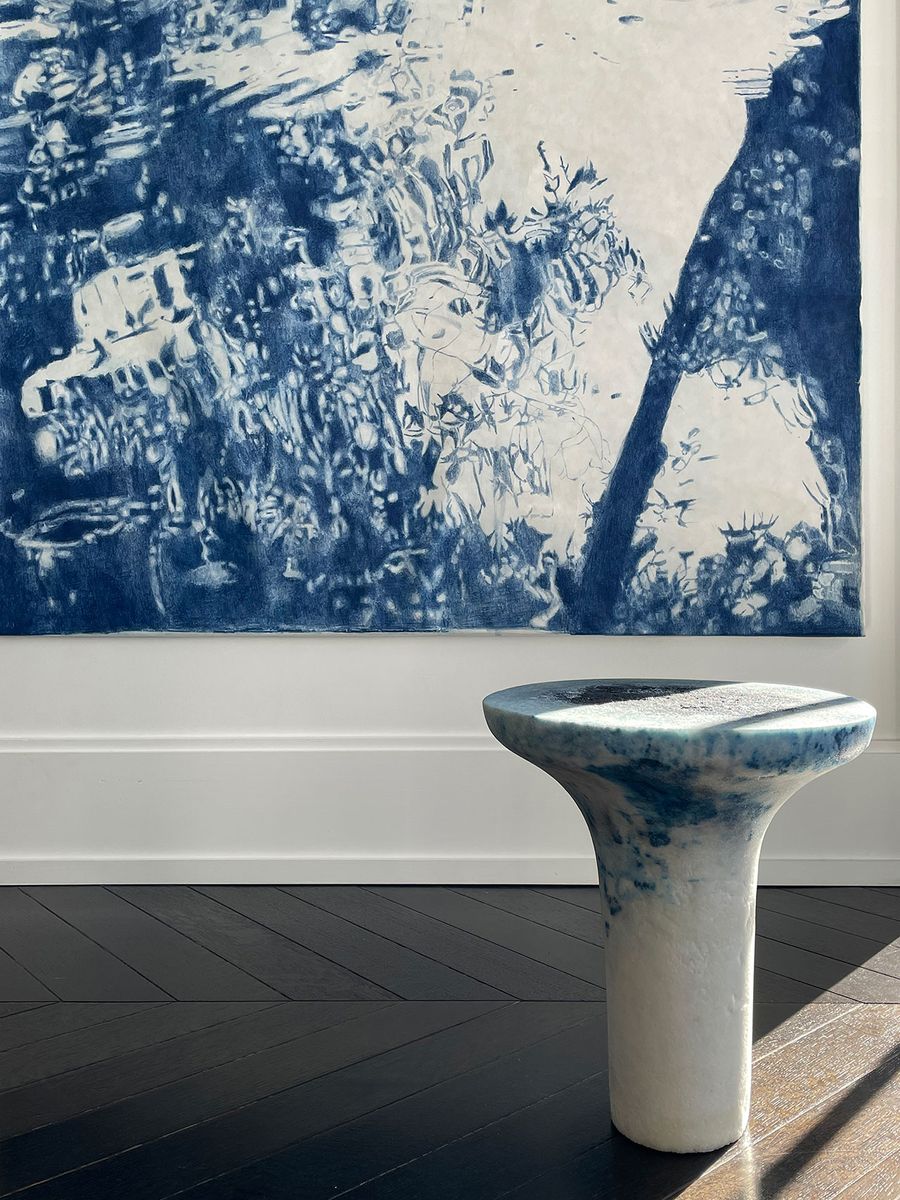
Galerie Philia at Walker Tower, Chelsea, New York. Courtesy of Galerie Philia.
Featured:
Flora Temnouche, Portraits de Rousseau. Pencil on japanese paper. 150 × 200 cm.
Roxane Lahidji, Salt Gueridon, 2019. Marbled Salt.

Galerie Philia at Walker Tower, Chelsea, New York. Courtesy of Galerie Philia.
Featured:
Evan Fay, Lawless Fauteuil, 2020. Brass connections foam, scuba knit fabric, steel pipe. 111 x 80 x 120 cm.
Monolithic works that appear as primitive objects abound, from the cubist forms of Swedish designer Lucas Morten’s black “Kub” chair, inspired by brutalist architecture and the ziggurats of ancient Mesopotamia, and Belgian designer Arno Declercq’s handcrafted solid oak candleholder, to the phallic minimalism of Nikhil Paul’s brass sculpted floor lamp for his lighting brand Paul Matter, the totem-likeness of Vince Skelly’s “Corsica Tower” hand-sculpted by a single block of oak, to the organic forms of Philadelphia-based Studio Noon’s candy-pink cement chair.
The marriage of organic with geometric forms is yet another connecting link between the exhibition’s heterogeneous pieces as attested by the stunning “Infinity” alabaster chandelier by Paris-based Atelier Alain Ellouz, Nina Edwards Anker’s twisted “Landscape” sofa for her brand nea studio, French ceramist Elisa Uberti’s stoneware table lamps, and the faceted, mineral-shaped sculptures by Awaré, a collaboration between sculptor Jérôme Pereira and visual artist Sylvia Eustache Rools. Other works embrace pure geometric forms like the ring-shaped “Gestalt” Bench by Belgian studio SMENT from designers Frederik Bogaerts and Jochen Sablon, the triangular “Alchemy” bronze and leather chair by Rick Owens, and the arched brass bench by the exhibition’s co-curator Pietro Franceschini.
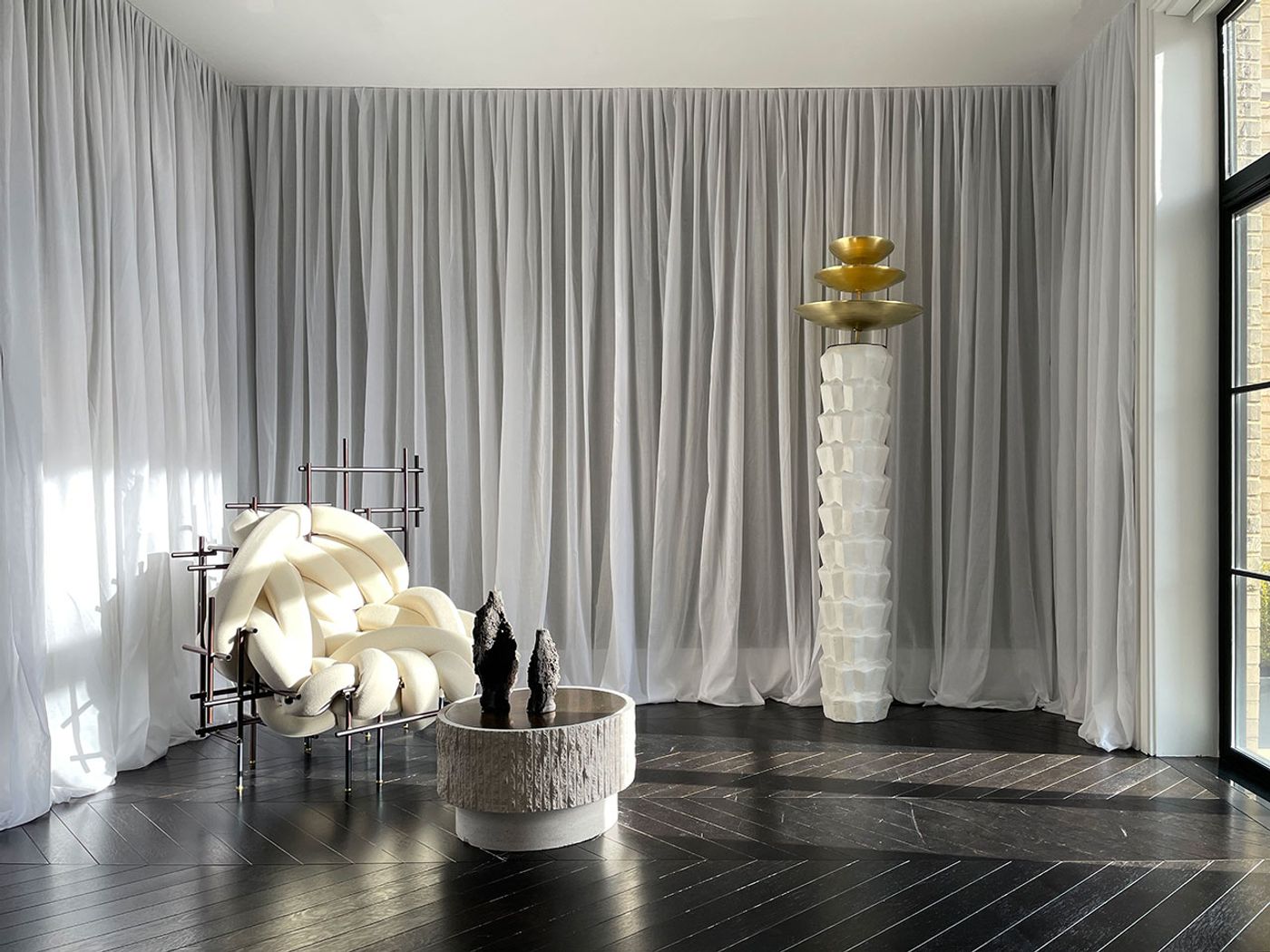
Galerie Philia at Walker Tower, Chelsea, New York. Courtesy of Galerie Philia.
Featured:
Evan Fay, Lawless Fauteuil, 2020. Brass connections foam, scuba knit fabric, steel pipe. 111 x 80 x 120 cm.
Frédéric Saulou, Ambiguë coffee table, 2020. Ornamental stone, Magny, patinated brass. H 34, D 60 cm.
Niclas Wolf, Geoprimitive ceramic and brass candelstand Candleholder, 2020. Ceramic and brass.
Rooms, Miami Floor Lamp, 2018. Combined composite and brass.
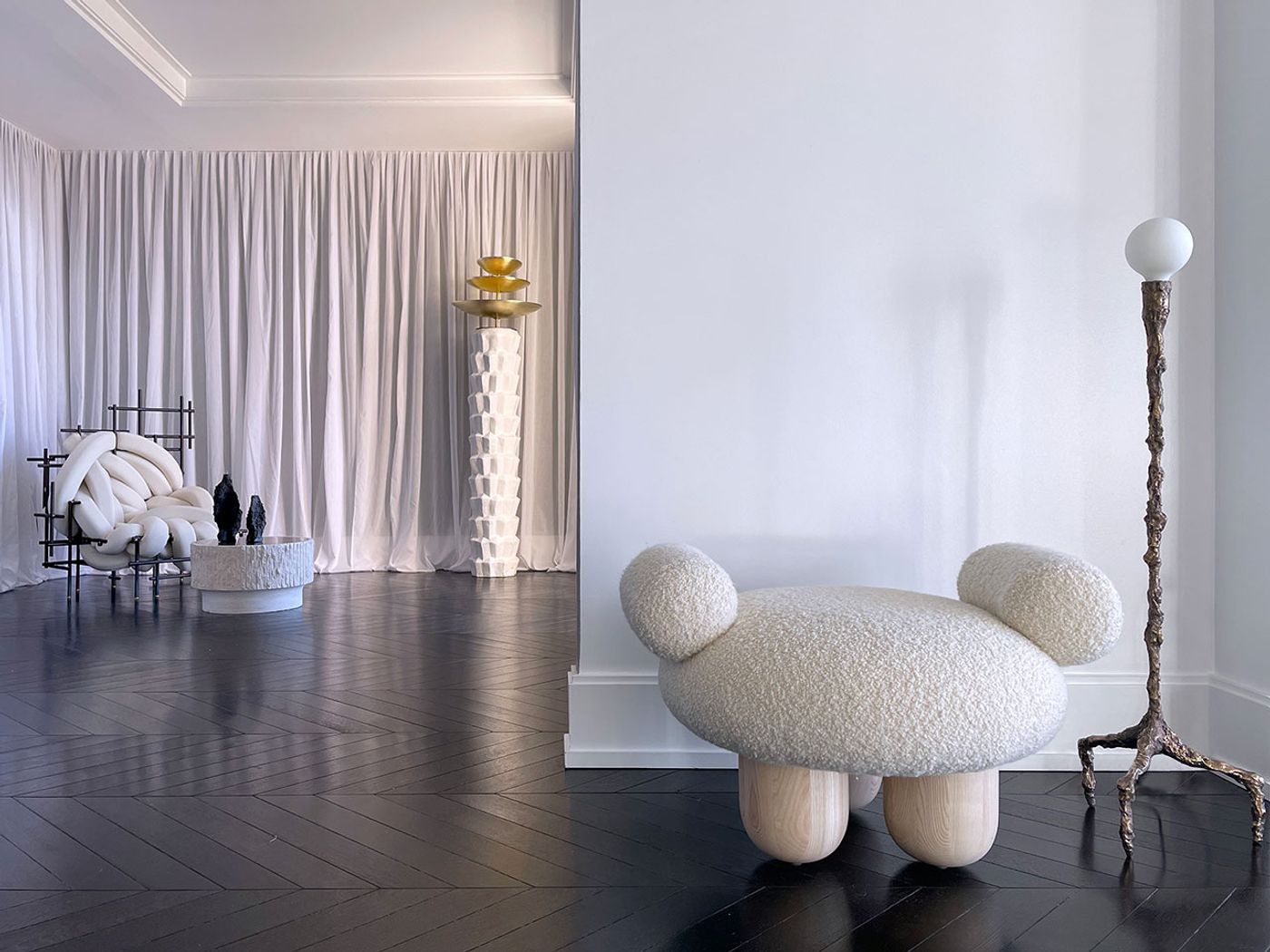
Galerie Philia at Walker Tower, Chelsea, New York. Courtesy of Galerie Philia.
Featured:
Pietro Franceschini, Bling Bling, 2020. Ottoman. Ash Wood, Lamb. 79 x 43 x 63 cm.
William Guillon, Sweet Thing IV, Unique Bronze Sculptural Lamp, 2019. Bronze.
130 x 38 x 38 cm.
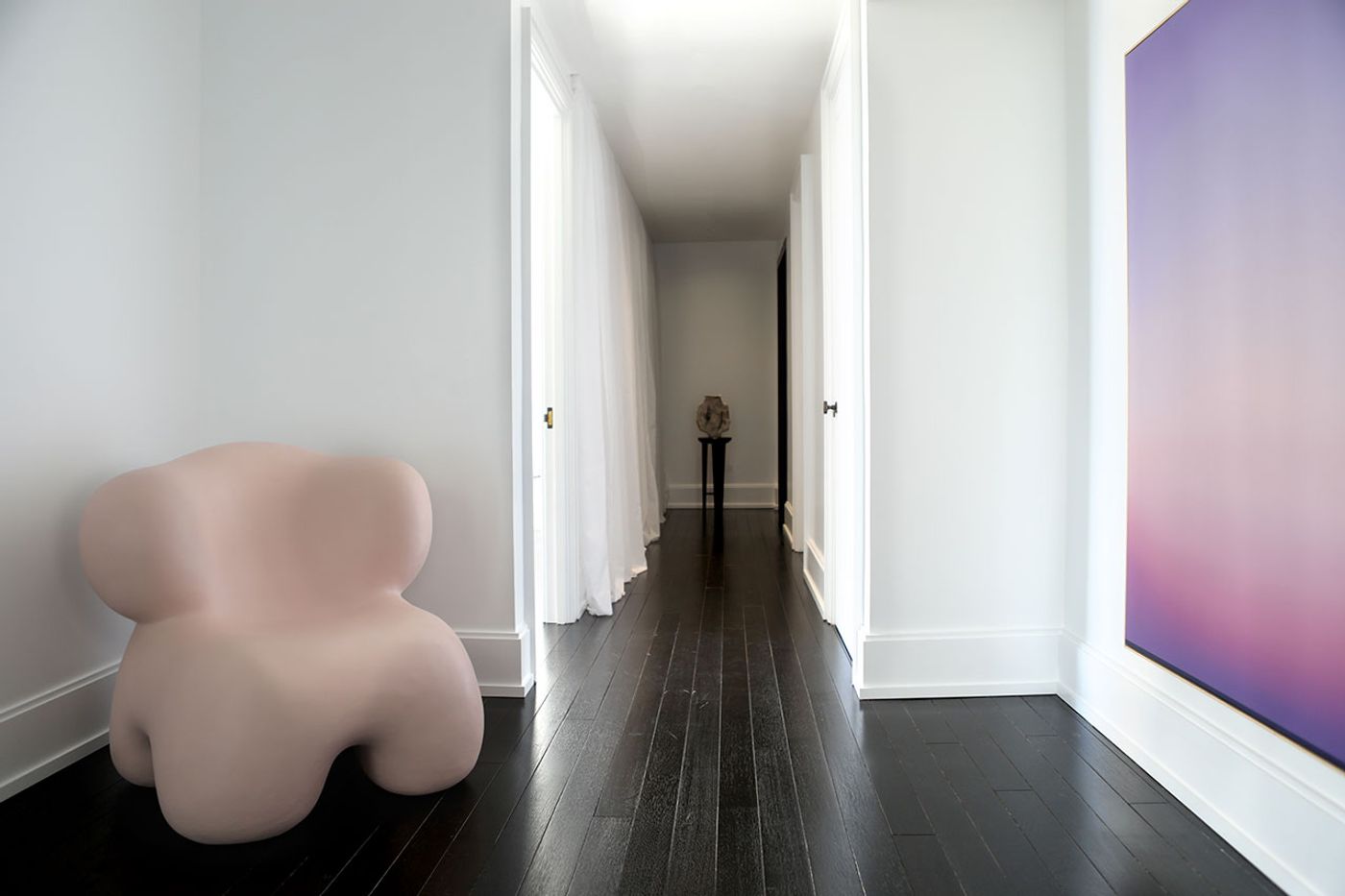
Galerie Philia at Walker Tower, Chelsea, New York. Courtesy of Galerie Philia.
Featured:
Studio Noon, Chair. Pigmented Cement.
Théo Pinto, Beautiful Pollution, 2020. Oil and Resin on Panel. 165 x 124 cm.
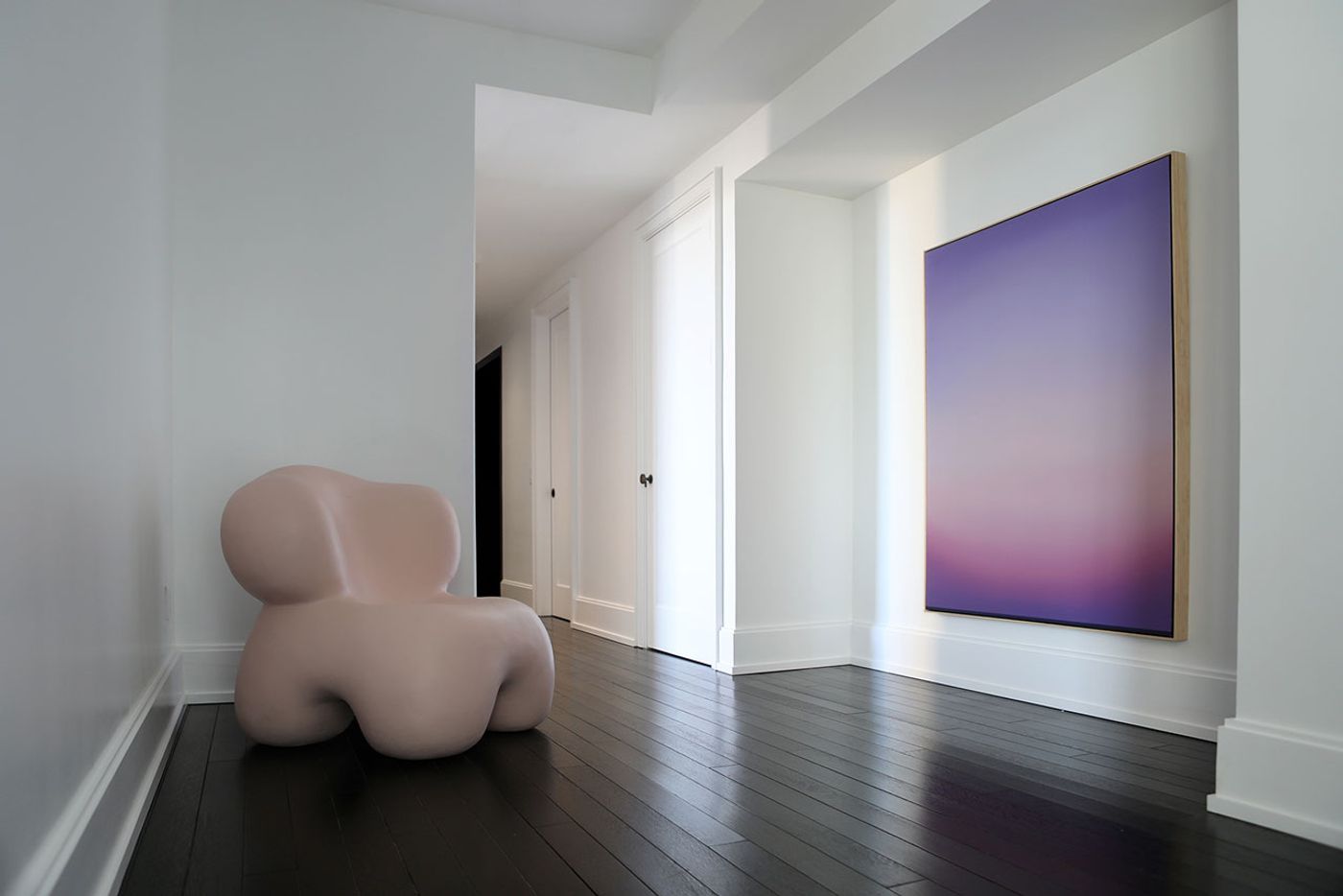
Galerie Philia at Walker Tower, Chelsea, New York. Courtesy of Galerie Philia.
Featured:
Studio Noon, Chair. Pigmented Cement.
Théo Pinto, Beautiful Pollution, 2020. Oil and Resin on Panel. 165 x 124 cm.
Softening the predominantly black, white and brass colour palette, Dutch designer Laurids Gallée's “Green Console”, Sander Bottinga’s fringed table lamp, and the volcanic rock side table “Life on Earth” by Nata Janberidze and Keti Toloraia’s Tbilisi-based design studio Rooms add subtle green accents. More colour is to be found in the last room, nicknamed the “pastel bedroom” on account of its pink, yellow and green hues. Stealing the limelight is a lemon-coloured, totem-like floor lamp by young French designer Léa Mestres, whose whimsical work draws inspiration from artists such as Niki de Saint Phalle and Wendell Castle, and Brazilian-born, New York-based artist Théo Pinto’s evocative painting titled “Late Summer Twilight”.
More than a collection of beautifully crafted objects, the curators’ achievement lies in creating a coherent mise-en-scène despite their heterogeneity, a liveable space where nothing feels out of place or out of context. Set against the New York City skyline, the diverse works on display can’t help but echo the multifaceted yet harmonious urban landscape outside.
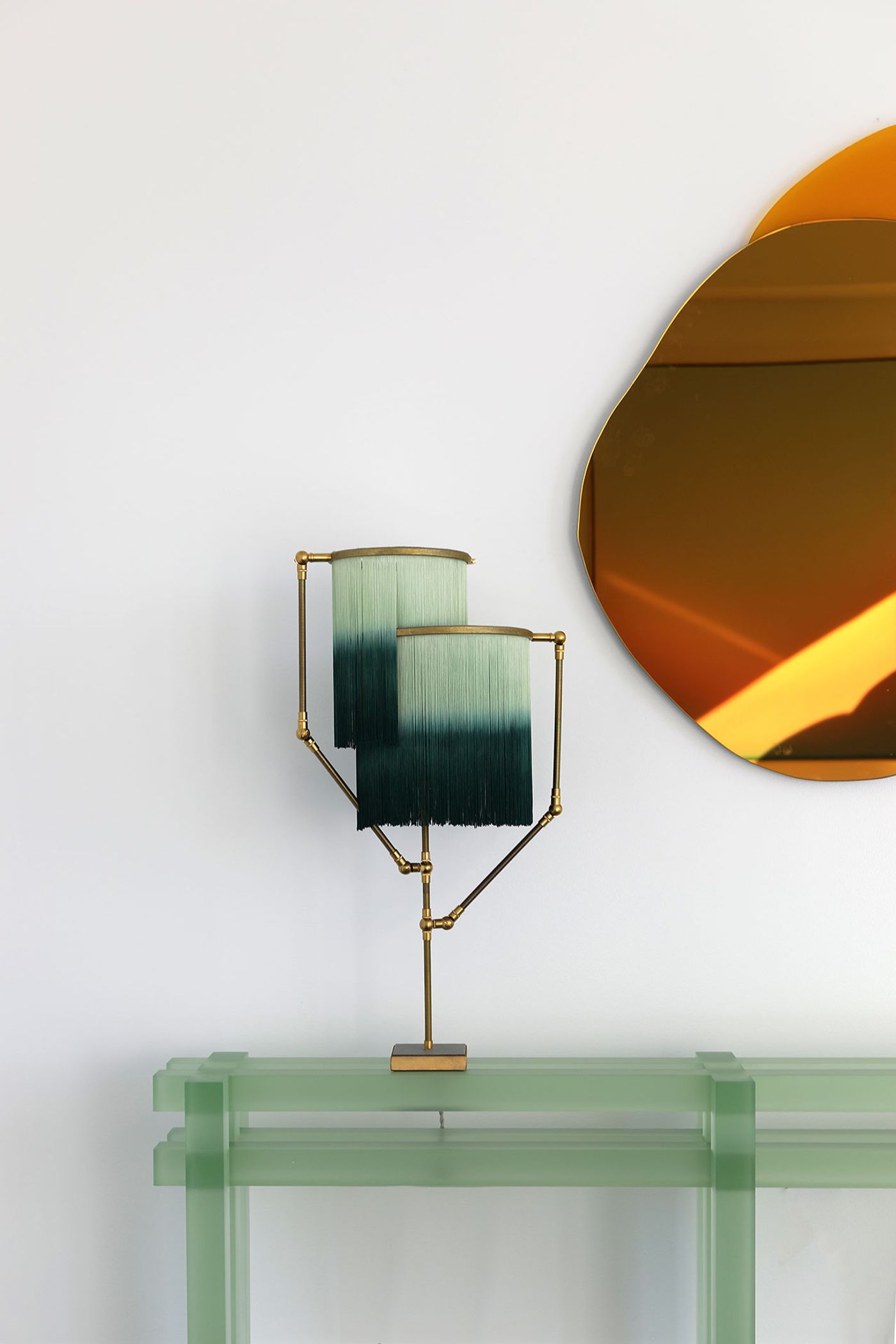
Galerie Philia at Walker Tower, Chelsea, New York. Courtesy of Galerie Philia.
Featured:
Laurène Guarneri, Ombrée hand-sculpted mirror, 2020. Gold mirror, yellow glass. 85 x 100 x 1.3 cm.
Sander Bottinga, Charme Table Lamp, 2019. Brass, Leather, Viscose, Wood. 73 x 38 x 25 cm.
Laurids Gallée, Green Console. Resin. 150 x 25 x 70 cm.

Galerie Philia at Walker Tower, Chelsea, New York. Courtesy of Galerie Philia.
Featured:
Léa Mestres, Sculptural Floor Lamp.
Théo Pinto, Late Summer Twilight, 2020. Oil and resin on panel. 165 x 124.5 x 6.4 cm.
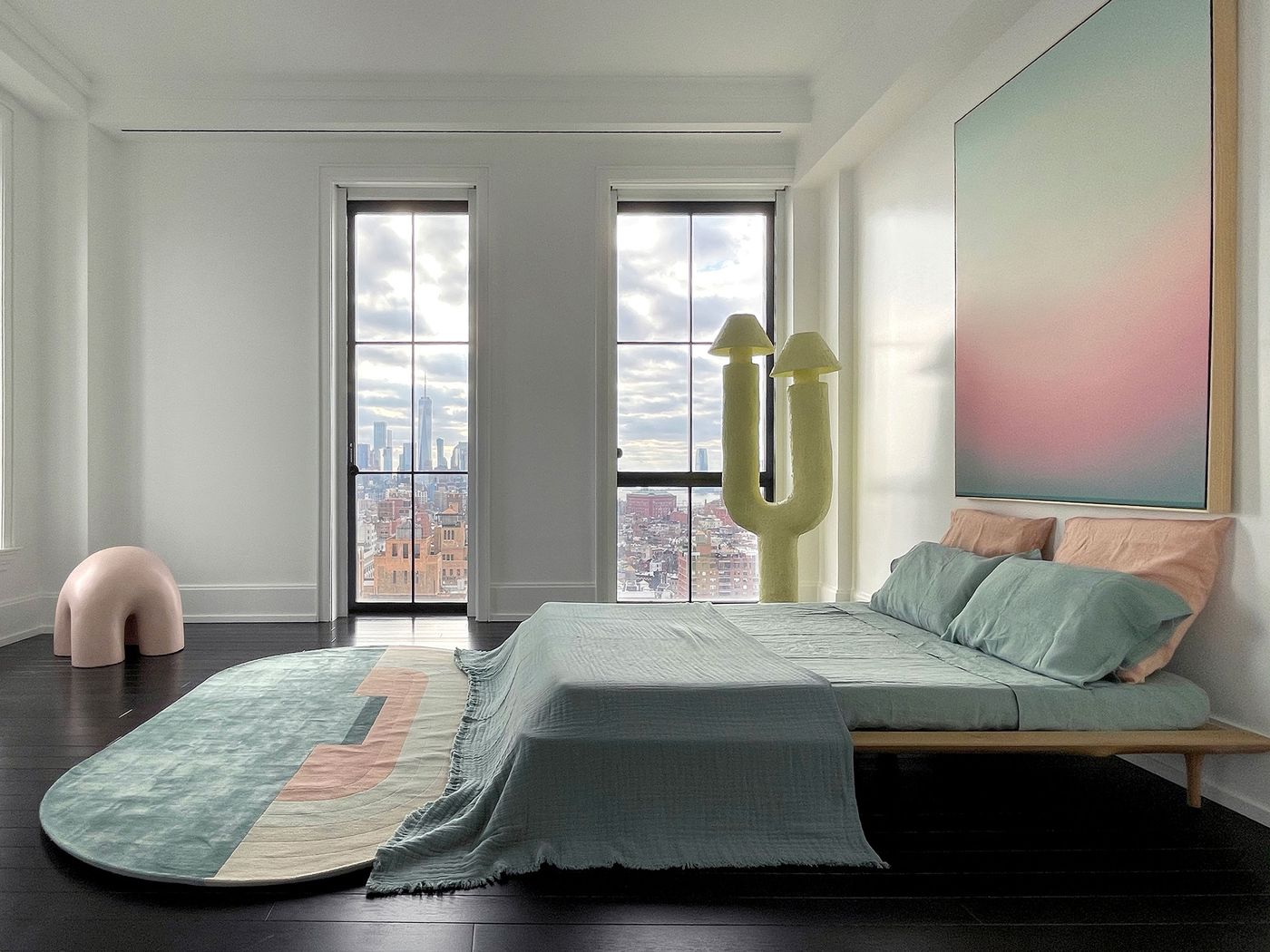
Galerie Philia at Walker Tower, Chelsea, New York. Courtesy of Galerie Philia.
Featured:
Studio Noon, Elephante Stool, 2019. Pigmented Cement. 61 × 61 × 61 cm.
Léa Mestres, Sculptural Floor Lamp.
Théo Pinto, Late Summer Twilight, 2020. Oil and resin on panel. 165 x 124.5 x 6.4 cm.

Galerie Philia at Walker Tower, Chelsea, New York. Courtesy of Galerie Philia.
Featured:
Arno Declerq, Senufo ottoman natural. African walnut and sheep wool. W 45 x D 45 x H 40 cm.
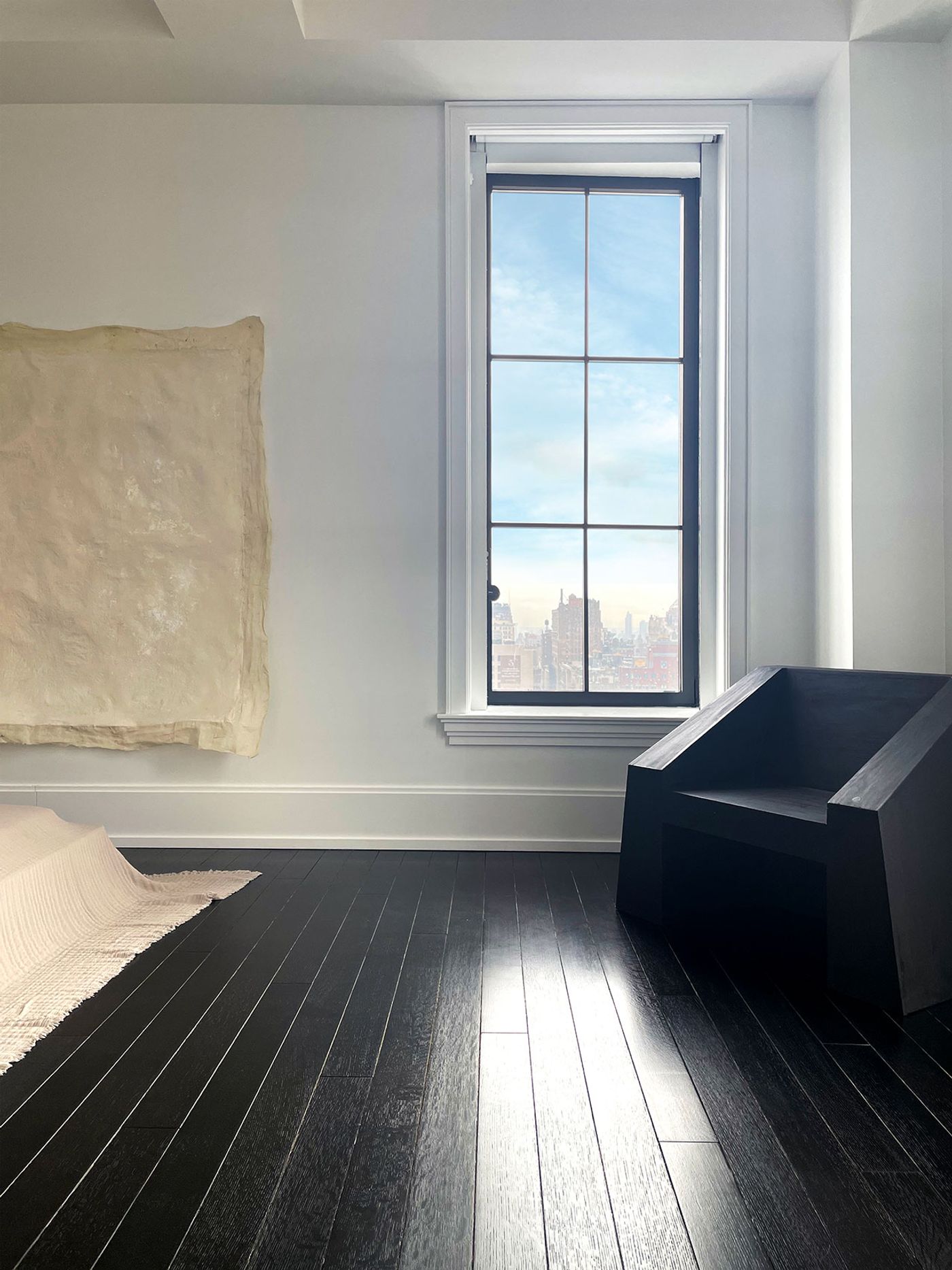
Galerie Philia at Walker Tower, Chelsea, New York. Courtesy of Galerie Philia.
Featured:
Lucas Morten, Kub Chair, 2020. Handwaxed Plywood. 95 x 65 x 75.5 cm.
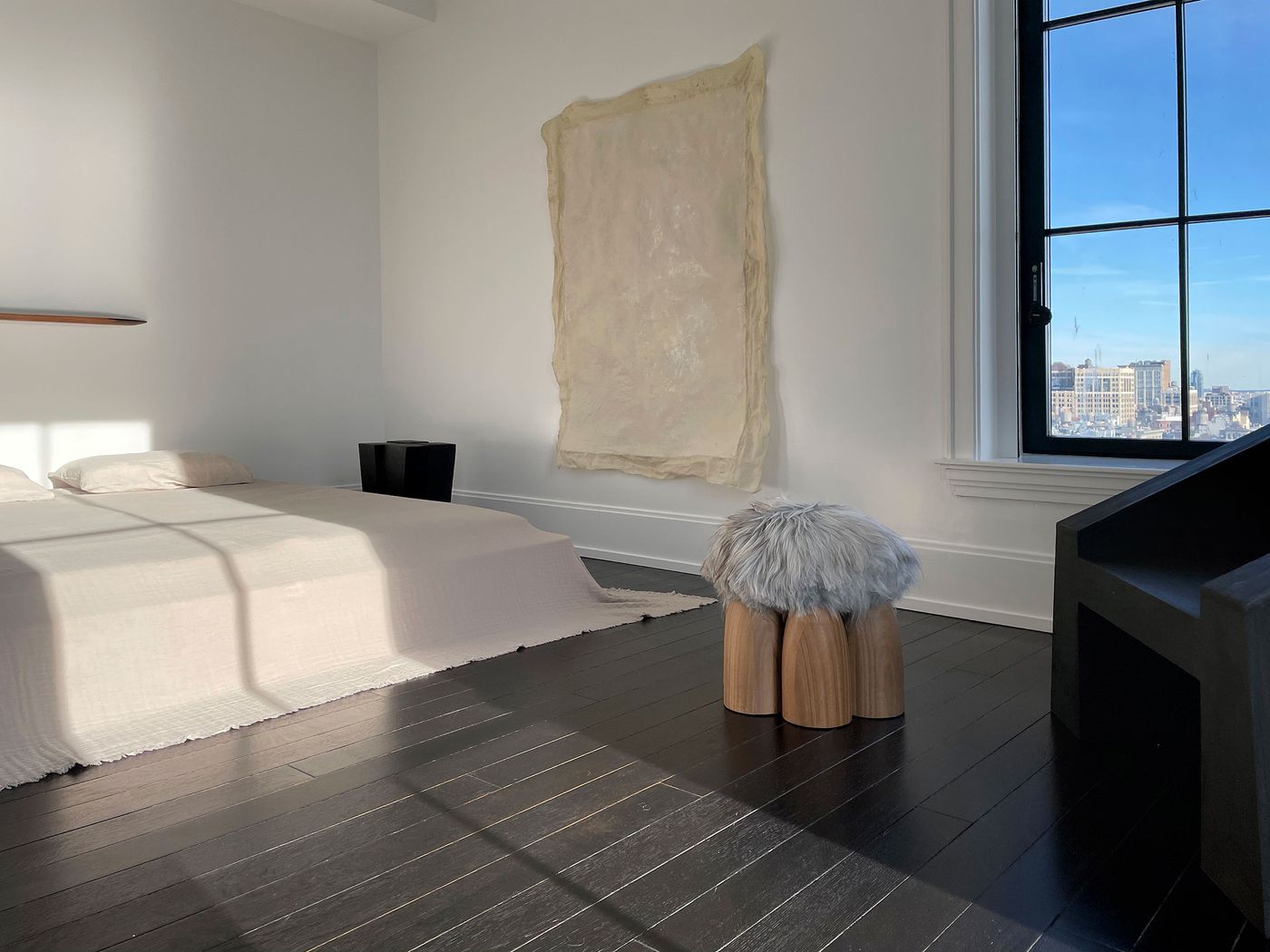
Galerie Philia at Walker Tower, Chelsea, New York. Courtesy of Galerie Philia.
Featured:
Arno Declerq, Senufo ottoman natural. African walnut and sheep wool. W 45 x D 45 x H 40 cm.
Lucas Morten, Kub Chair, 2020. Handwaxed Plywood. 95 x 65 x 75.5 cm.
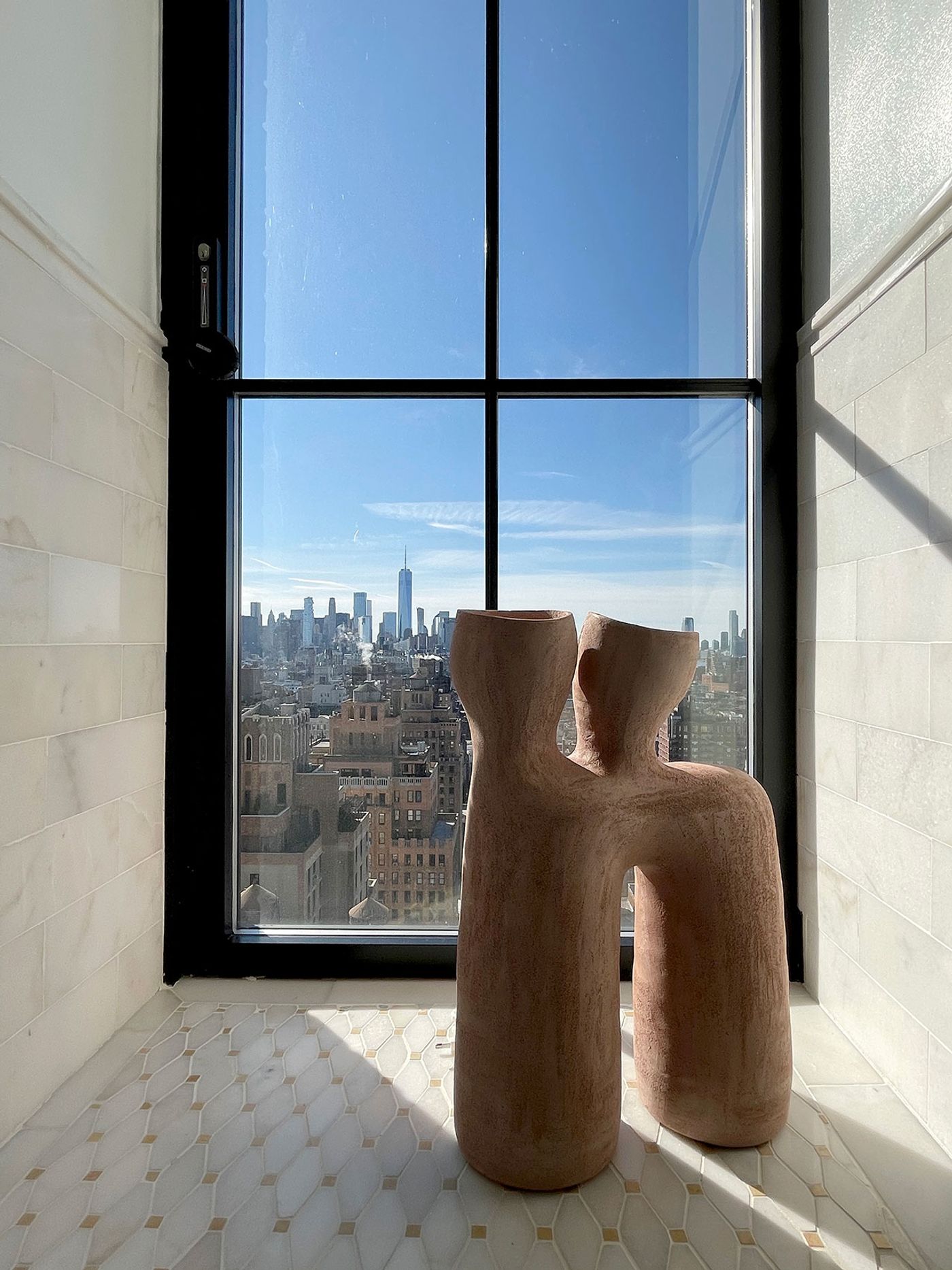
Galerie Philia at Walker Tower, Chelsea, New York. Courtesy of Galerie Philia.
Featured:
Elisa Uberti, Opéra table lamp. Pink Stoneware. 55 x 36 x 17 cm.